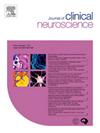Sensory integration dysfunction in adolescent idiopathic scoliosis: Insights from a clinical balance assessment using the m-CTSIB
IF 1.9
4区 医学
Q3 CLINICAL NEUROLOGY
引用次数: 0
Abstract
Sensory integration dysfunction contributes to postural instability, particularly in conditions challenging vestibular and proprioceptive processing. This study evaluated balance function in adolescent idiopathic scoliosis (AIS) using the modified Clinical Test of Sensory Interaction on Balance (m-CTSIB).A cross-sectional study was conducted with 80 participants (40 AIS, 40 controls), assessing postural stability under various sensory conditions, including a novel foam-surface, eyes-closed, head-movement condition designed to challenge vestibular function. AIS patients exhibited significantly greater center of pressure (COP) deviations, movement velocity, and elliptical area than controls (P < 0.05), suggesting deficits in vestibular recalibration and sensory reweighting.Subgroup analysis revealed that lumbar scoliosis patients had greater postural instability than those with thoracic curves, suggesting differences in proprioceptive feedback. These findings may reflect that AIS-related balance deficits stem from sensory integration dysfunction rather than spinal deformity severity alone. This study highlights the need for targeted neurorehabilitation, including vestibular therapy and proprioceptive training, to improve postural control in AIS. Future research should explore neurophysiological mechanisms and rehabilitation efficacy.
青少年特发性脊柱侧凸的感觉统合功能障碍:使用 m-CTSIB 进行临床平衡评估的启示
感觉统合功能障碍有助于体位不稳定,特别是在前庭和本体感觉加工受到挑战的情况下。本研究使用改进的平衡感觉相互作用临床测试(m-CTSIB)评估青少年特发性脊柱侧凸(AIS)的平衡功能。80名参与者(40名AIS患者,40名对照组)进行了一项横断面研究,评估了各种感觉条件下的姿势稳定性,包括一种新的泡沫表面、闭眼、头部运动条件,旨在挑战前庭功能。AIS患者的压力中心(COP)偏差、运动速度和椭圆面积明显大于对照组(P <;0.05),提示前庭重新校准和感觉重新加权的缺陷。亚组分析显示腰椎侧凸患者比胸侧弯患者有更大的姿势不稳定性,提示本体感觉反馈的差异。这些发现可能反映了ais相关的平衡缺陷源于感觉统合功能障碍,而不仅仅是脊柱畸形严重程度。本研究强调需要有针对性的神经康复,包括前庭治疗和本体感觉训练,以改善AIS患者的姿势控制。未来的研究应进一步探讨神经生理机制和康复疗效。
本文章由计算机程序翻译,如有差异,请以英文原文为准。
求助全文
约1分钟内获得全文
求助全文
来源期刊

Journal of Clinical Neuroscience
医学-临床神经学
CiteScore
4.50
自引率
0.00%
发文量
402
审稿时长
40 days
期刊介绍:
This International journal, Journal of Clinical Neuroscience, publishes articles on clinical neurosurgery and neurology and the related neurosciences such as neuro-pathology, neuro-radiology, neuro-ophthalmology and neuro-physiology.
The journal has a broad International perspective, and emphasises the advances occurring in Asia, the Pacific Rim region, Europe and North America. The Journal acts as a focus for publication of major clinical and laboratory research, as well as publishing solicited manuscripts on specific subjects from experts, case reports and other information of interest to clinicians working in the clinical neurosciences.
 求助内容:
求助内容: 应助结果提醒方式:
应助结果提醒方式:


